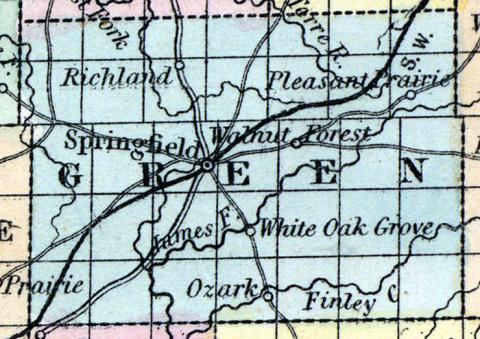GREENE COUNTY, situated toward the southwesterly part of Missouri, and traversed by White river. Area, 1,000 square miles. Face of the country level, and in some parts hilly; soil productive. Seat of justice, Springfield. Pop. in 1840, 5,372; in 1850, 12,785. (Fanning's, 1853)
GREENE, a county in the S. S. W. part of Missouri, has an area of 1218 square miles. The Niangua, Pomme de Terre, and Sac rivers, affluents of the Osage, rise in the county, and flow towards the north. It is intersected by James river and Finley creek, which flow south-westward, and unite with White river of Arkansas. The surface is diversified by hills of moderate height; the soil is generally fertile and the water good. The county contains numerous prairies, alternating with forests of oak, hickory, walnut, &c. Indian corn, wheat, oats, hay, cattle, and pork are the staples. In 1850 it produced 1,110,987 bushels of corn; 61,306 of wheat; 288,769 of oats; 900 tons of hay, and 306,757 pounds of butter. The above quantity of oats was the greatest raised in any county of the state. It contained 8 churches, and 2 newspaper offices; 259 pupils attending public schools, and 275 attending academies or other schools. Limestone underlies a large part of the county, and lead ore is found in it. It is copiously supplied with springs and with water-power. Capital, Springfield. Population, 12,785, of whom 11,555 were free, and 1230, slaves. (Baldwin & Thomas, A New and Complete Gazetteer of the United States ... 1854)

